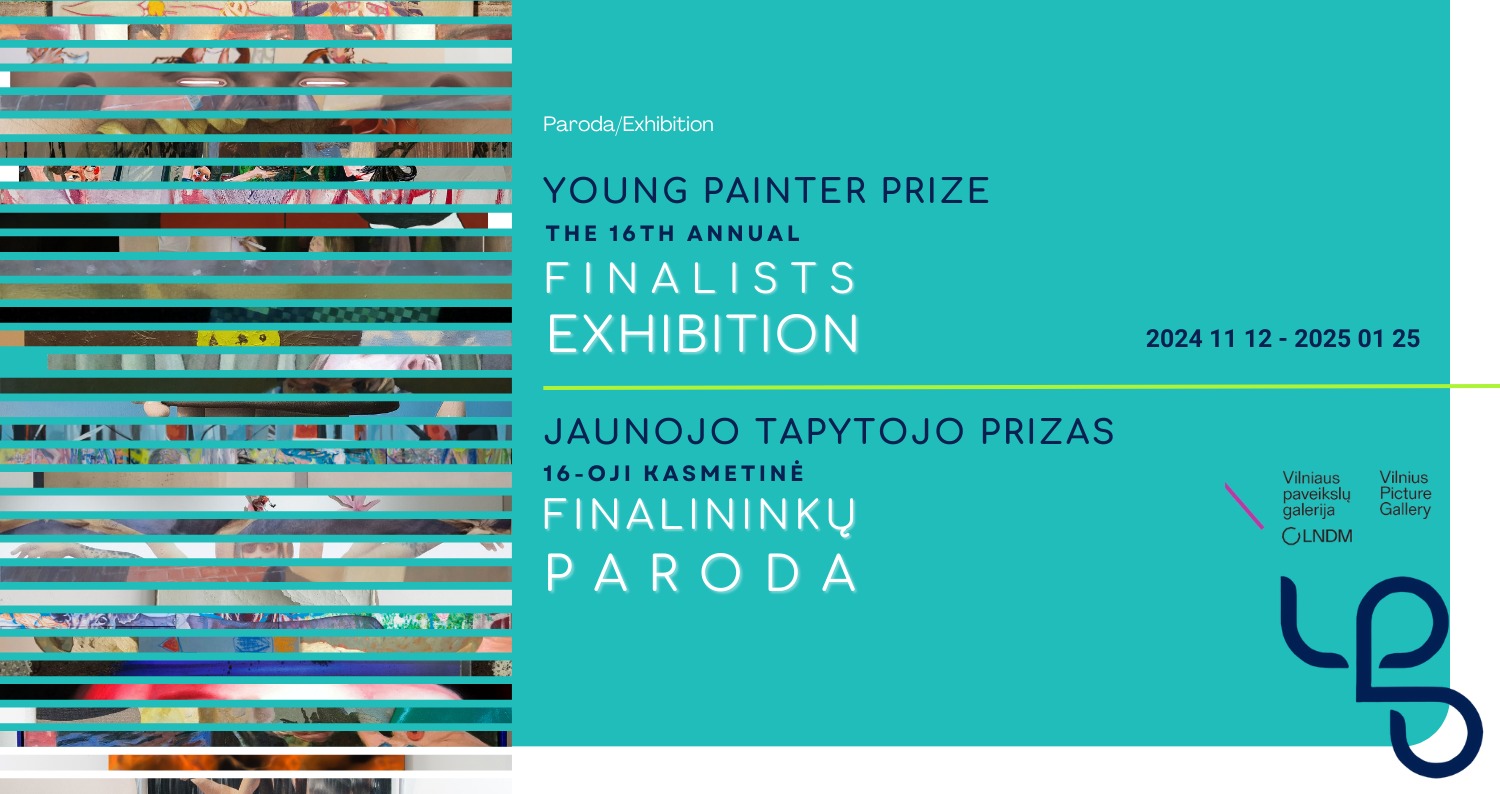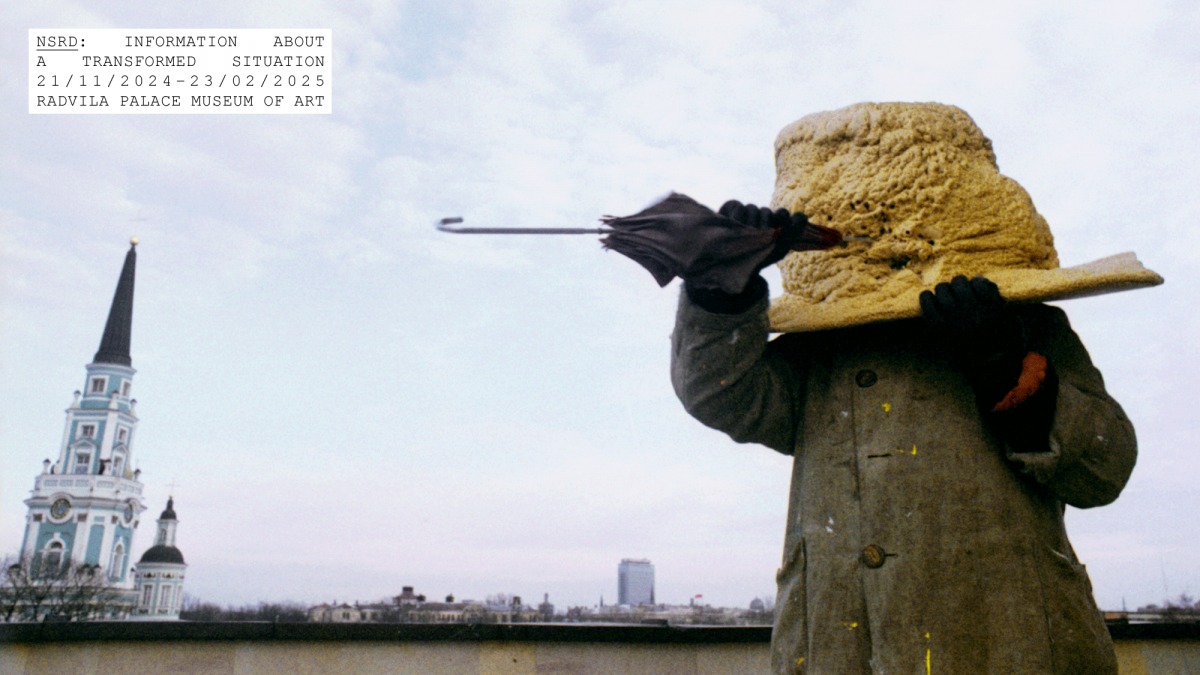
What to see in the Baltics
Must-see art exhibitions in November-December, 2024
Autumn slowly transitions into winter, and we become more reflective, taking stock of the year. We step into exhibition halls to ponder more deeply what art is and what it does to us (as explored in Orbita’s Stage Works project in Riga), and how art fills and plays with space (a theme wonderfully represented at the 15th Baltic Triennial at the recently renovated Contemporary Art Centre in Vilnius). During this time, we not only reflect but also share what we've managed to create and conceive. Thus, two exhibitions by Estonian artists, prepared in collaboration with the Kogo Gallery from Tartu, are opening in Riga at LOOK! Gallery and at the Kim? Contemporary Art Centre. We also look more attentively at the past, showcasing masters of painting (such as Kaja Kärner at the Adamson-Eric Museum in Tallinn) and photography (Gunars Binde at the Latvian National Museum of Art). We observe and reflect – now, we have the time for it.
Kai Art Centre
Signe Fensholt, Lo and Behold. 2020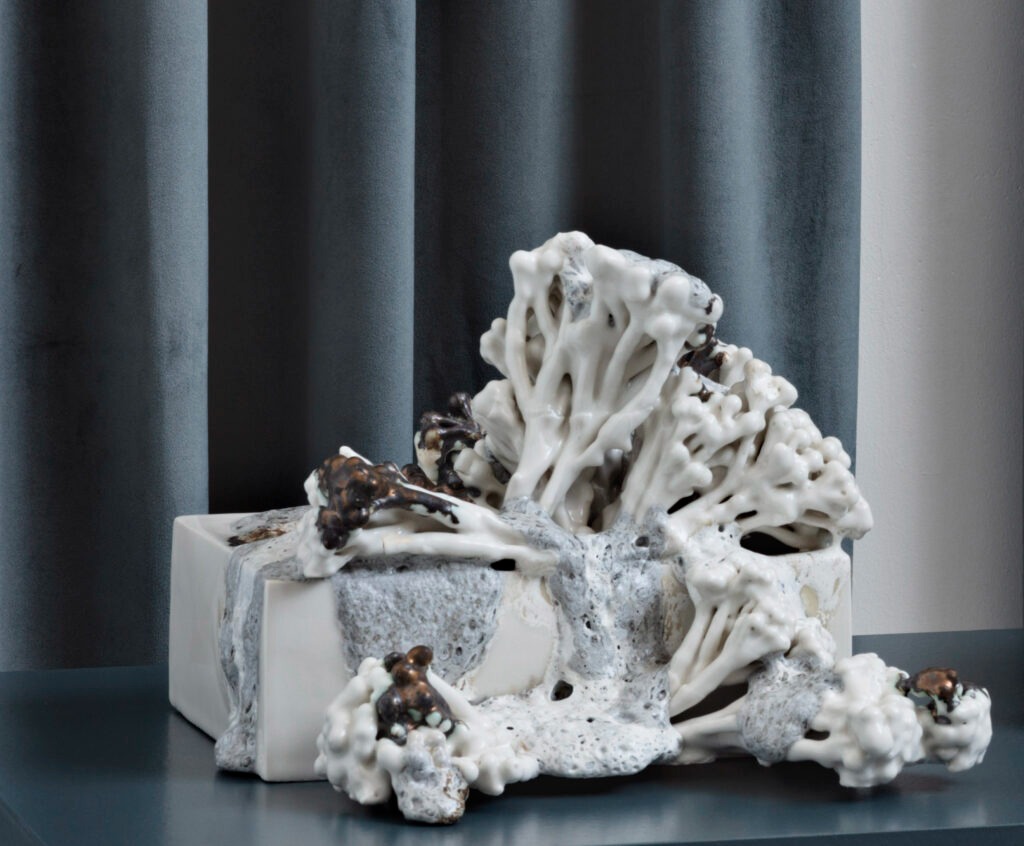
The Fine Lines of Constructiveness
Until 16 February
The main exhibition of the 9th Tallinn Applied Art Triennial The Fine Lines of Constructiveness features artists from the Baltic and Nordic countries, representing fields of applied art and contemporary craft, including a variety of techniques and materials. It showcases the diverse oeuvre of 27 solo artists and one artist group. “Constructiveness can be characterized by clarity, straightforwardness and optimality. It is aimed at development, creative progress, (re)constitution. Constructiveness may emerge when means are scarce, energy is low, or when the need to sustain one another has been acknowledged,” says the curator Maret Sarapu about the main theme of the triennial.
Many of the exhibited works use time-consuming technologies, which, in addition to highlighting the importance of sustainability, raise the question of whether handicraft as a soothing activity is a basic need, a luxury, or, paradoxically, both. The triennial includes textiles, glass, ceramics, jewelry, and installations – while many of the works are experimentations with a view of the future, they also value techniques from thousands of years ago.
Kumu Art Museum
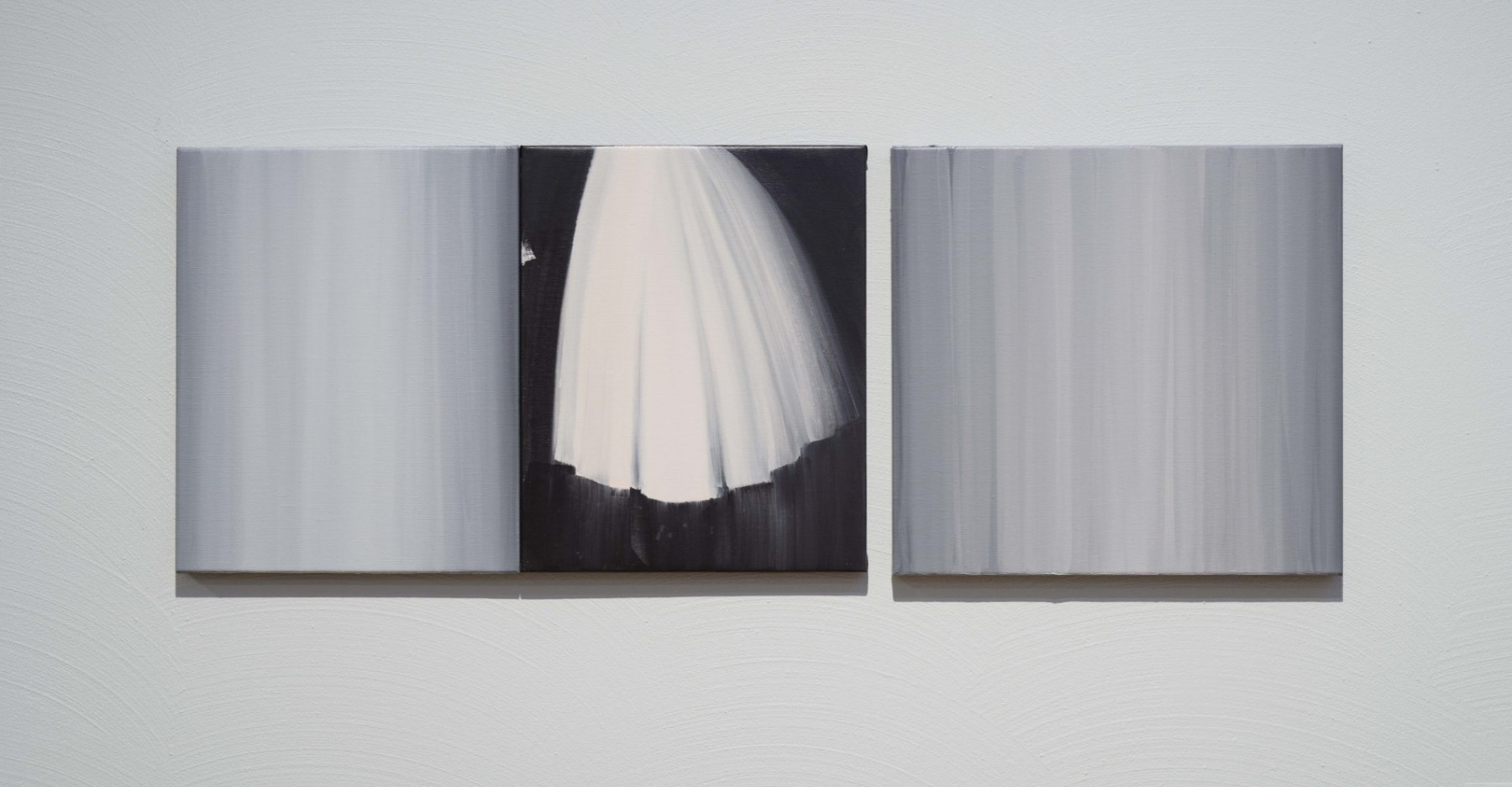
Sirja-Liisa Eelma. Longing for Lost Space
Until 30 March
Sirja-Liisa Eelma (1973) is a minimalist conceptual painter whose oeuvre mainly deals with emptiness, silence and the relationship between the visible and the invisible. Her art is characterised by meditativeness and gentleness, and her works offer the viewer space for moments of rest and introspection. Eelma is fascinated by the poetics of space. Her paintings and installations are often site-specific and based on the principle of seemingly repetitive images, as well as varying combinations of shades and motifs. The artist’s use of predominantly pastel colours is sensitive, considered and nuanced. The scenes in Eelma’s paintings often exude sacral lightness, transcendence and a yearning for a lost paradise.
Eelma is interested in space that is not yet full of meanings, space that existed before us. Her art includes references to different epochs, architectural styles and interiors, yet she does not pursue historical accuracy. The initial impulses for the exhibition Longing for Lost Space were a sense of silence and timelessness emanating from 19th-century Biedermeier interiors, and the possible meanings and interactions between hidden and visible spaces.
The Life and Death of Mr. N: Bourgeois Spaces
Rudolf Grossmann (1881–1941). Woman on a Lawn. 1915–1920. Watercolour, coloured pencil and gelatin printing. Art Museum of Estonia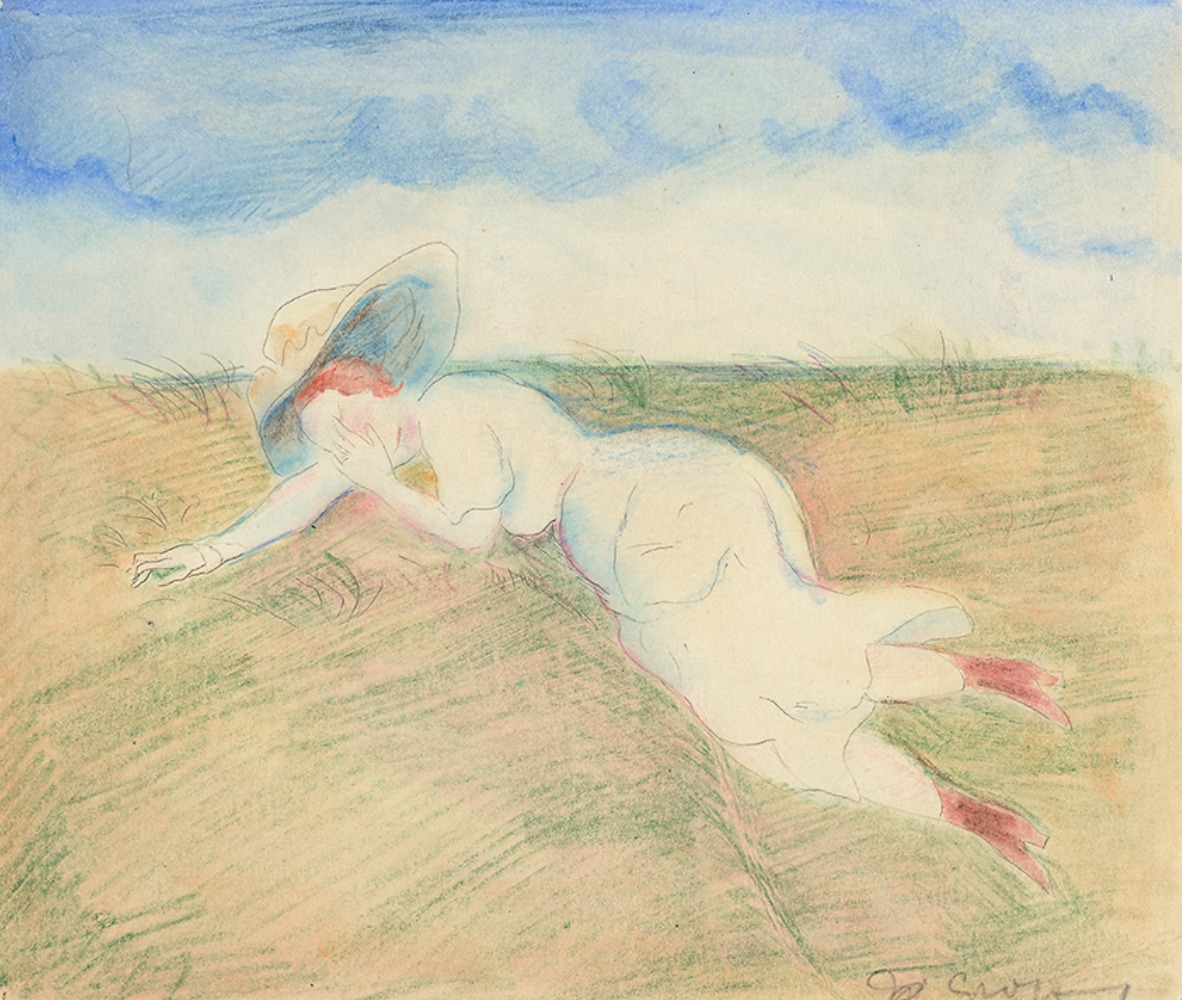
The exhibition The Life and Death of Mr. N by Urmas Lüüs takes us into the house-museum of the fictional character Mr. N, telling the story of the birth of the bourgeoisie in Estonia, with the help of new objects by Lüüs and works from museum collections. The exhibition includes works by Eduard Wiiralt, Johannes Mülber, Oskar Kallis, August Weizenberg, Erna Kreischmann, Hando Mugasto, Endel Kõks, Amandus Adamson and many other artists from the collections of the Art Museum of Estonia and other Estonian museums. The historical furniture and items on display come from the collections of the Art Museum of Estonia and private collections.
Urmas Lüüs (b. 1987) has studied blacksmithing and creates large-scale installations and performances. His solo exhibitions have often had a narrative texture, introducing spatial environments where someone has seemingly resided or often visited. Shifts, interruptions and impossibilities occur in these spaces, creating a poetic and figurative level. This exhibition includes numerous objects and works of art from various museum collections in order to simulate historical authenticity and to create new labyrinths of ideas. There is also a certain disquiet to Lüüs’s exhibitions: underneath the apparent sense of security, there is a palpable and disgusting danger and decay. Lüüs builds worlds and immediately tears them down.
Tallinn Art Hall
Exhibition view. Photo: Paul Kuimet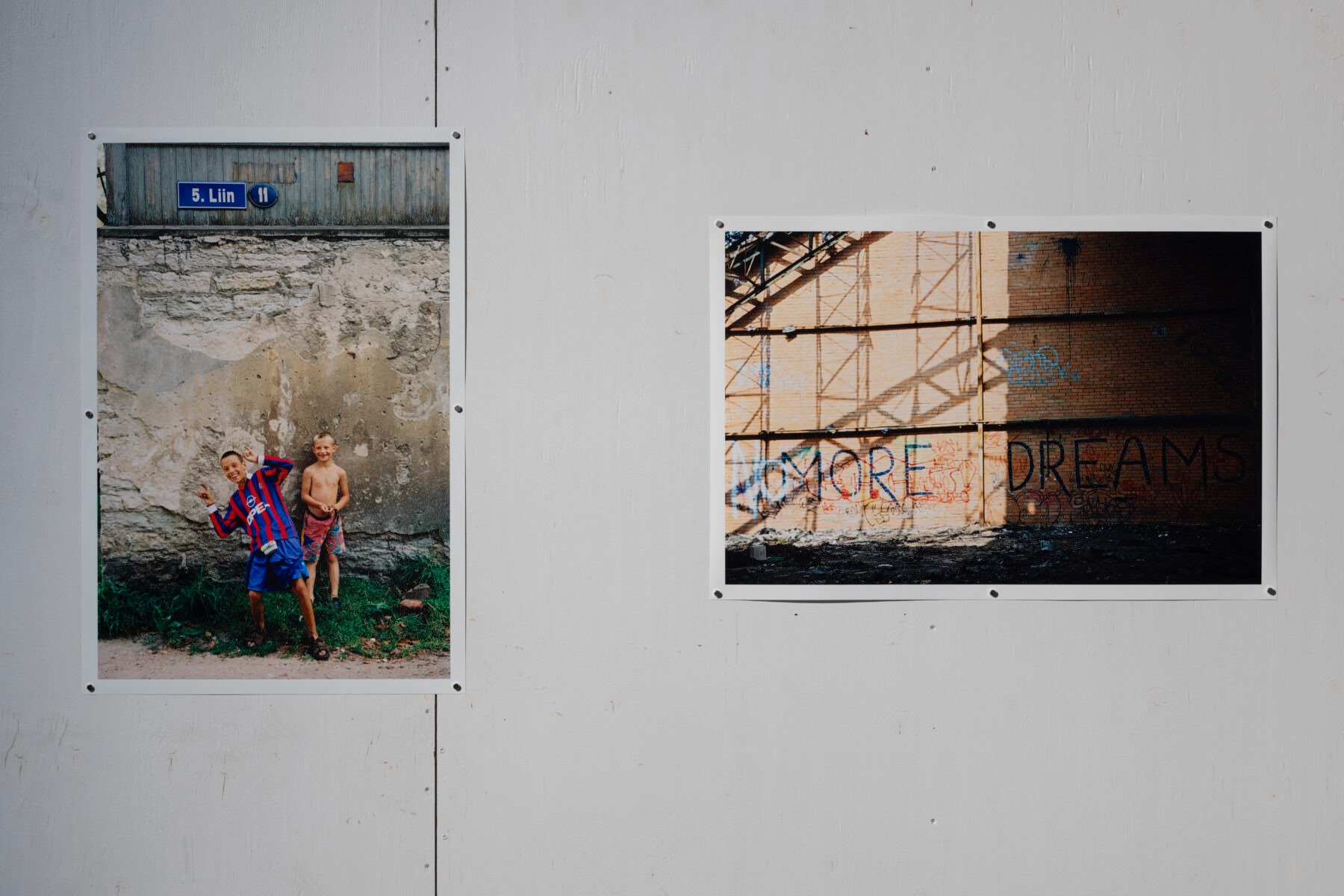
My Home, Our City
Until 12 January
The exhibition format is inspired by the metaphor of a box set: the pavilion’s spaces are filled with works that explore various facets of urban life and the concept of home. The exhibition is curated by Siim Preiman.
The exhibition features internationally recognised artists Laura Cemin, Foxy Haze, Tõnis Jürgens, Samuel Lehikoinen, Camille Laurelli, Metabor, Mark Raidpere, Romain Sein, Jaakko Pietiläinen, Mark Soosaar, Diana Tamane, Ingel Vaikla and Mari Volens. The artists’ photo and video works create a captivating journey through the pavilion’s spaces, ranging from brutalist concrete architecture to the intimacy of the human body. “Home seems to be one of those concepts that everyone feels and understands, but always in their own unique way,” explains exhibition curator Siim Preiman. The exhibition My Home, Our City delves into the ambitious legacy and contradictory reality of modernist cities. It raises the question: how does a sense of home emerge in a standardised urban environment? The artists’ works explore both the influence of architecture in shaping daily life and how residents, in turn, modify and personalise the space to meet their own needs.
Fotografiska

Nude
Until 5 January
In art we have mostly been presented with the same kind of nude through history – the generally considered beauty of the time. A consideration most often decided and depicted by men, for an audience of men. What if we could press reset here and now, and see what this new contemporary nude looks like, how it is used, and what it tells us about society today, free from its biased historical constraints. Autumn at Fotografiska begins with a powerful start – on September 13th, the exhibition 'NUDE' opens its doors, showcasing the work of 32 female artists exploring the theme of the nude body. Among them are Estonian artistst Cloe Jancis and Marlen Kärema. Through various creative approaches, the exhibition breaks away from traditional depictions of the nude body, presenting it in all its shameless honesty and glory, with contemporary freshness and freedom from constraints, all seen through the female gaze. The result is an environment where expected roles no longer apply, habitual perspectives shift, and power hierarchies are overturned.
EKKM
Photo: Priit Simson
Ene-Liis Semper’s solo exhibition
Until 15 December
Ene-Liis Semper’s solo exhibition brings together a collection of layers and imageries in different rooms and floors of Contemporary Art Museum of Estonia taking into focus the current moment in time. The objects, sculptures, video works, sound and light design staged in various spaces of the museum form a whole that oscillates in the liminal space between the critical consciousness and the subconsciousness filled with rich allusions. According to the artist, the ambiguous fragments of memory that have found their way to the exhibition, are marked by tension and anticipation rather than by stillness.
Semper wishes to mirror the end of one process, or rather its transition, the breaking point. “There is a deep feeling that we have reached a moment where the skills and information acquired so far are no longer valid. Figuratively speaking, one can feel the cracking of the surface layer as if it were an eggshell. But what or who will come out of it, is not yet clear,” says Semper..
Temnikova & Kasela Gallery
Eetu Sihvonen. Mourning Dew III (”One gentle push more, perhaps?”). 2024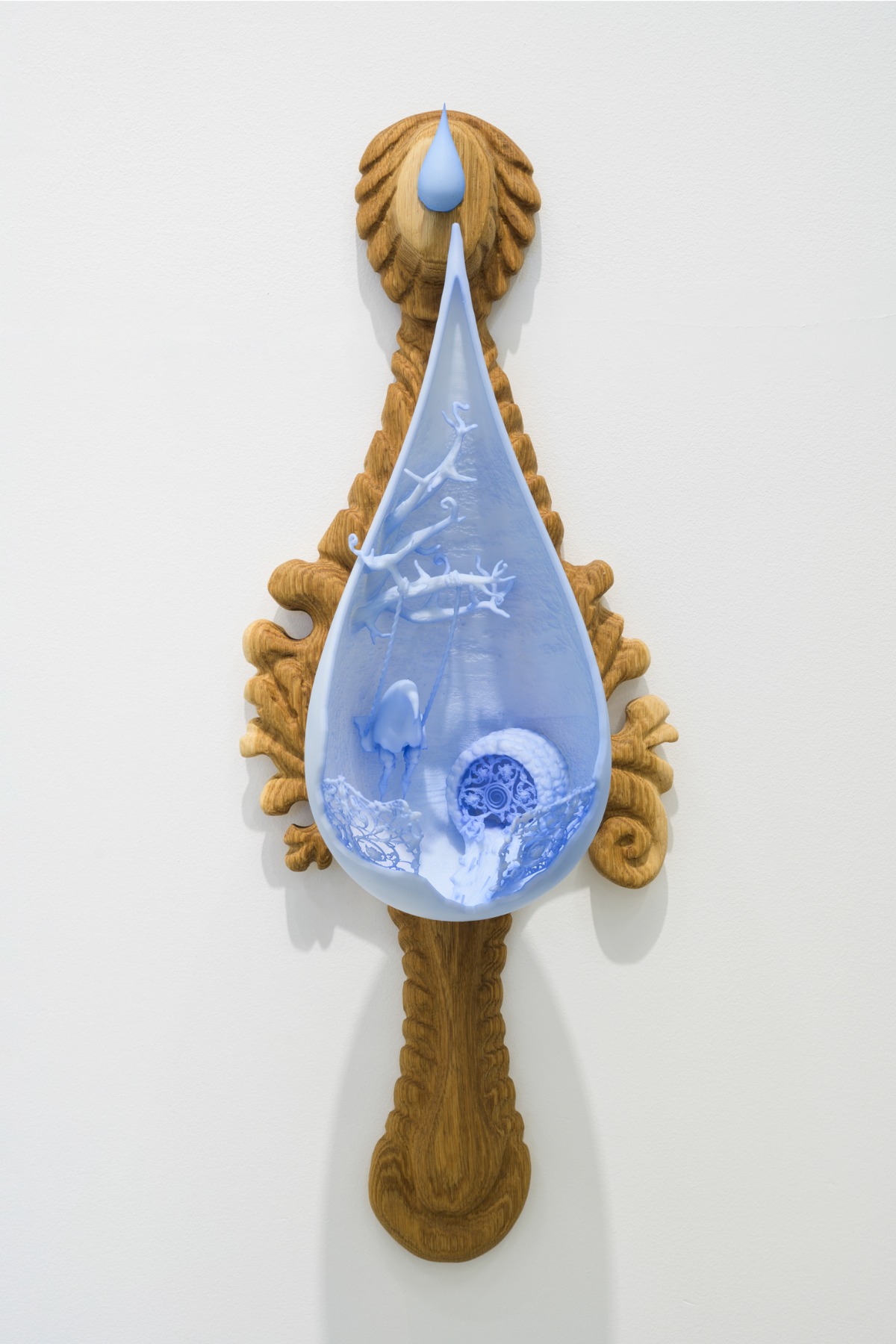
Man Yau, Eetu Sihvonen. Saline Binds
The exhibition Saline Binds brings together works by two Helsinki-based artists, Man Yau and Eetu Sihvonen. Although both artists are exhibiting works stemming from their individual and distinct practices, presenting very different artistic expressions, they also share a similar sensibility and a strong focus on material in their storytelling.
Man Yau’s work often takes a closer look at distinct cultural contexts and examines these through her own experience as a woman and a BIPOC artist. For example, her work addresses issues like exoticisation, the patriarchal gaze and the subsequent expectations of performativity. Yau counters these processes and resulting structures of power through creating artefacts that combine cultural analysis, personal experiences and are able to stand against stereotyping.
Eetu Sihvonen’s work presents a strange world with a cast of peculiar characters – Bruegel-like scenes in surreal humour. Inspired by the utopia of Cockaigne, an imaginary world of ease and abundance that stood in opposition to the harshness of medieval peasant life filled with labour and scarcity. So, the world Sihvonen constructs through their artworks is not one of godly splendour or high-class luxury but rather hails from a more down-to-earth utopia, regardless of presenting elements of fantasy and wonder.
Adamson-Eric Museum
Kaja Kärner (1920‒1998). Discussion. 1958. Oil on paper. Tartu Art Museum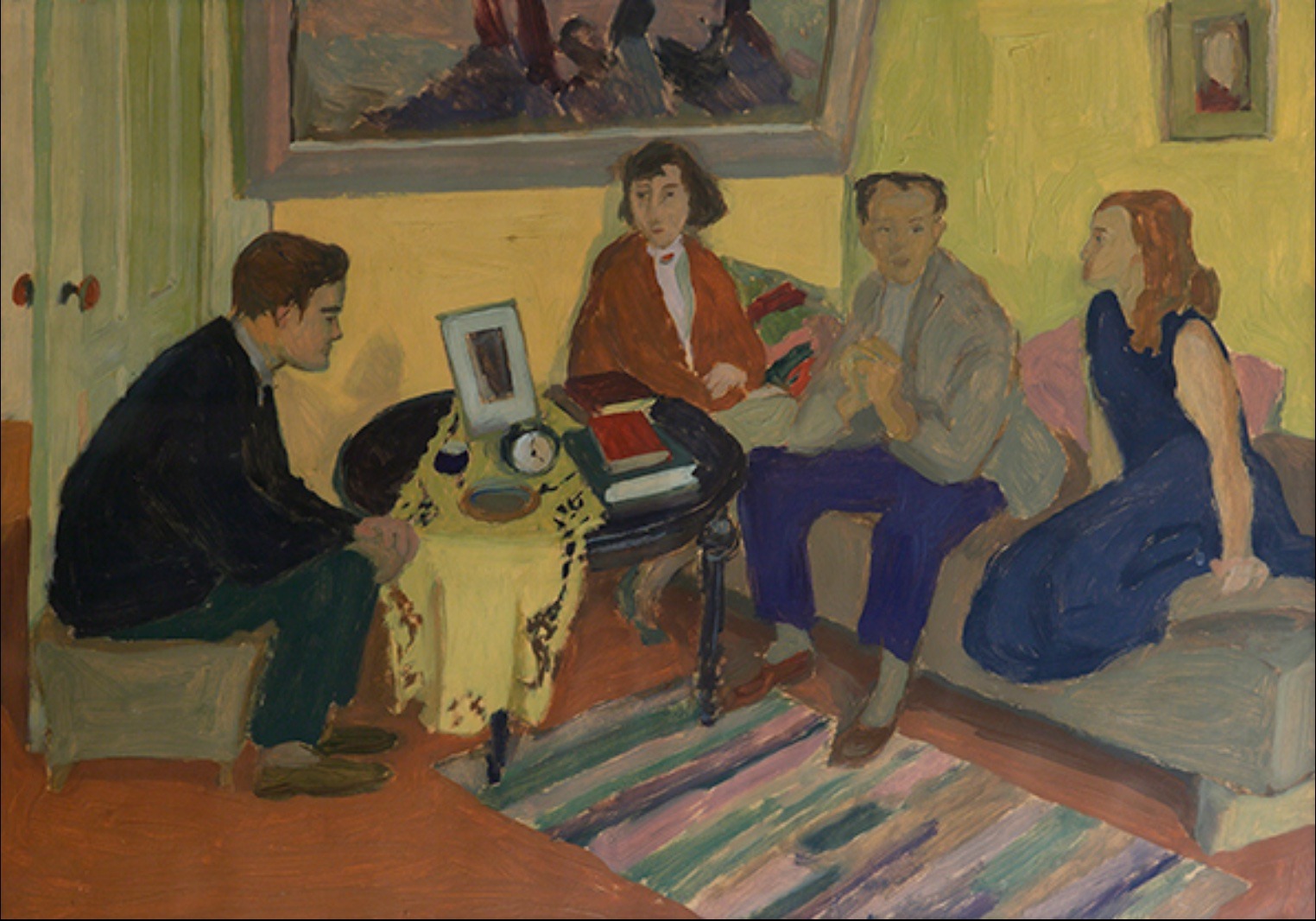
Kaja Kärner: Friendship and Time
Until 16 March
She belonged to the generation of artists who should have entered the art scene at the end of the 1940s, but as victims of Stalinist repressions many of her peers were sent to Siberian prison camps instead. Kärner was spared and was able to stay in Tartu, but still fell victim to the Soviet authoritarian system: she lost her job as a drawing teacher and was expelled from the Artists’ Association. For the next nine years, she worked officially as the label painter of Tartu Kaubastu (the Tartu branch of the state organisation of trade).
In 1956–1967, when men were returning from Siberia, the former fellow students and like-minded artists, i.e. “the boys” who had survived the prison camps and “the girls” who had survived repression at home, got together as the first post-World War II group of artists in Estonia, known as the Group of 1960, named after their only uncensored exhibition, held in 1960. The group passionately searched for an unofficial artistic language and new modern means of expression, but also devoted themselves to preserving the attitudes and aesthetics of the free pre-war art scene.
Mikkel Museum
Ülo Sooster. Landscape with Eyes. 1968. Oil. Private collection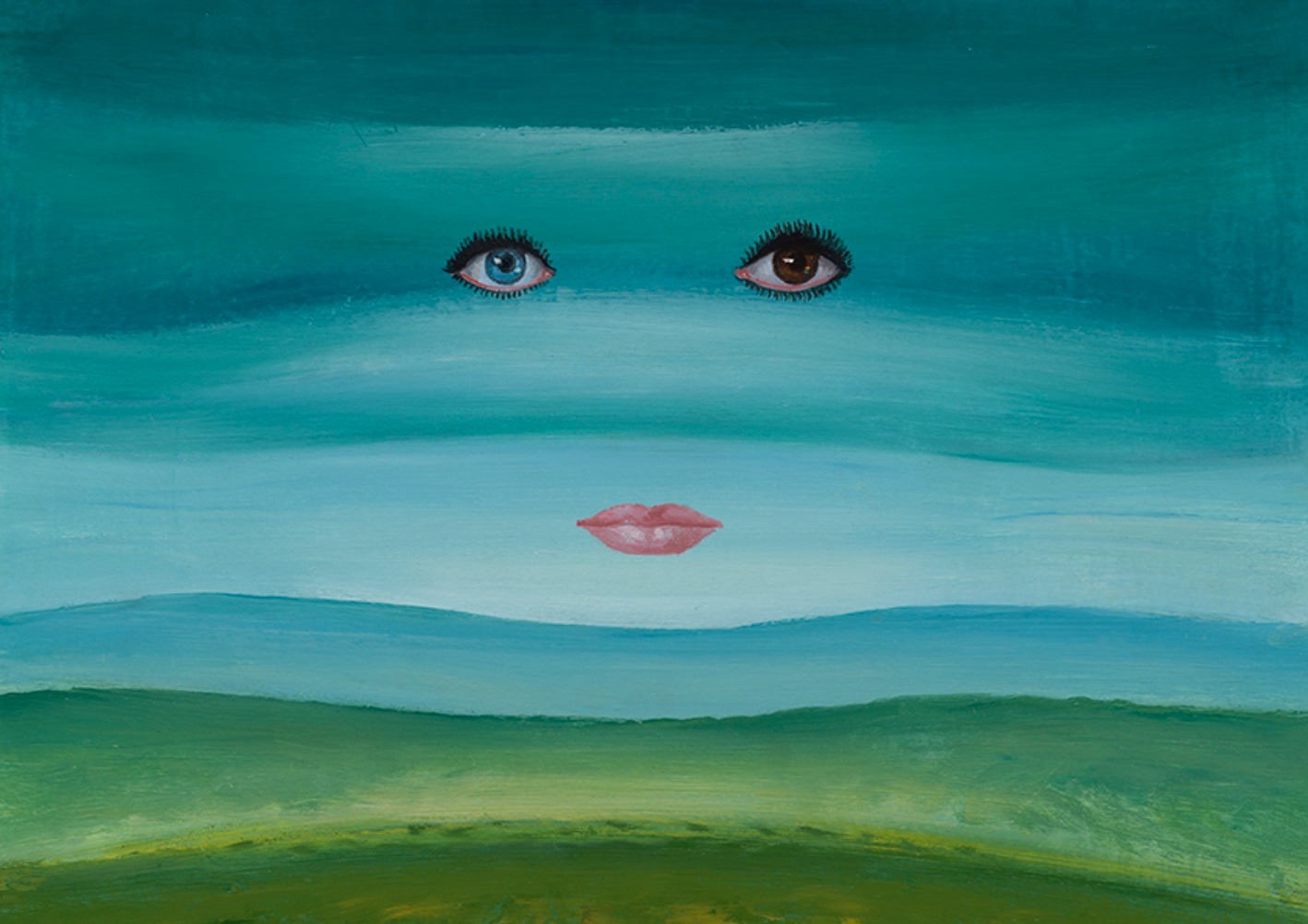
Sooster 100: View from Private Collections
Until 5 May
Ülo Sooster (1924–1970), despite his short life span, left behind a legacy of thousands of drawings and paintings, which, despite the Iron Curtain, are part of the history of surrealism in Europe. The exhibition dedicated to the 100th anniversary of Sooster’s birth brings together a selection of works in private collections by this uniquely playful creator, who was one of the most important innovators of Estonian post-war modernism. A gallery of self-portraits will function as an exhibition within the exhibition: it includes works from museums, and traces Sooster’s development from an underground artist excluded from public art life to a seminal figure in 20th century Estonian – and, more broadly, Eastern European – art history.
Dedicated to the artist’s 100th birthday, the exhibition takes a retrospective look at Sooster’s life and work: his early attempts at painting in Hiiumaa, his painterly period in Tartu under the influence of the Pallas Art School, the relief and serial works of his heyday in Moscow and the mysterious unfinished works of his last years. The view of Sooster based on the works in private collections enriches the artist’s current image by adding previously unknown rarities, confirming his reputation as a cultivator of cosmo-eroticism, radical for the Soviet era, and the creator of a distinctive artistic mythology built on the leitmotifs of the juniper, fish and egg. A total of seventeen private collectors have lent works to the exhibition, including a number of women collectors with interesting profiles, whose collections reveal Sooster’s special relationship with women. An important part of the exhibition is the Sooster family collection, which, thanks to the decision of the artist’s relatives, was brought from Moscow to Tartu in 1990, thus shifting the focus of research on Sooster’s legacy to Estonia.
Tartu
Estonian National Museum
Ryoji Ikeda. the critical paths. 2024
Ryoji Ikeda’s Solo Exhibition
Until 2 March
Originally from Japan and now based in Paris, Ryoji Ikeda is known for his unique style that combines scientific data and technology into contemporary artworks. He has received widespread acclaim in both art and electronic music circles, performing on stage and in exhibition halls. The Ryoji Ikeda exhibition at the Estonian National Museum is a rare opportunity to experience his world-class creations in Tartu.
Ikeda’s work has been greatly inspired by science and in 2014-2015 his residency at the European Organization for Nuclear Research (CERN) took place. His residency at CERN resulted in the piece supersymmetry, for which Ikeda received the prestigious Ars Electronica award (Collide@CERN 2014 Prix Ars Electronica.
In 2024, Ikeda is returning to Estonia more powerfully than ever before! Ryoji Ikeda's Solo Exhibition is part of the European Capital of Culture Tartu 2024 main programme.
LATVIA, Riga
Latvian National Museum of Art
Gunārs Binde. Game / Initiative.1982
BINDE 100–10
Until 19 January
During his photographer’s career spanning 67 years, Gunārs Binde (1933) has received both local and international recognition, earning dozens of awards for the works in foreign photography salons. The exhibition BINDE 100–10 reflects the artist’s path towards and through these achievements by creating a metaphorical diary of key events, themes and people, while occasionally interspersing the visual narrative with Binde’s personal reflections in both textual and audio format.
One of the key moments in the making of photographic images in the previous century took place in the photo laboratory – the exhibition richly presents compositions created over the course of complex experiments, revealing a variety of original techniques as well as the wonders and coincidences created in the process of developing analogue photographs. The exhibition BINDE 100–10 weaves together the never-before-seen with the long-forgotten; the aesthetical experience is enhanced by the well-considered exhibition design and specially commissioned musical accompaniment that reflects the artist’s boundless creativity and gives visitor the opportunity to momentarily become part of it.
Riga Contemporary Art Space
Photo: Pēteris Rūcis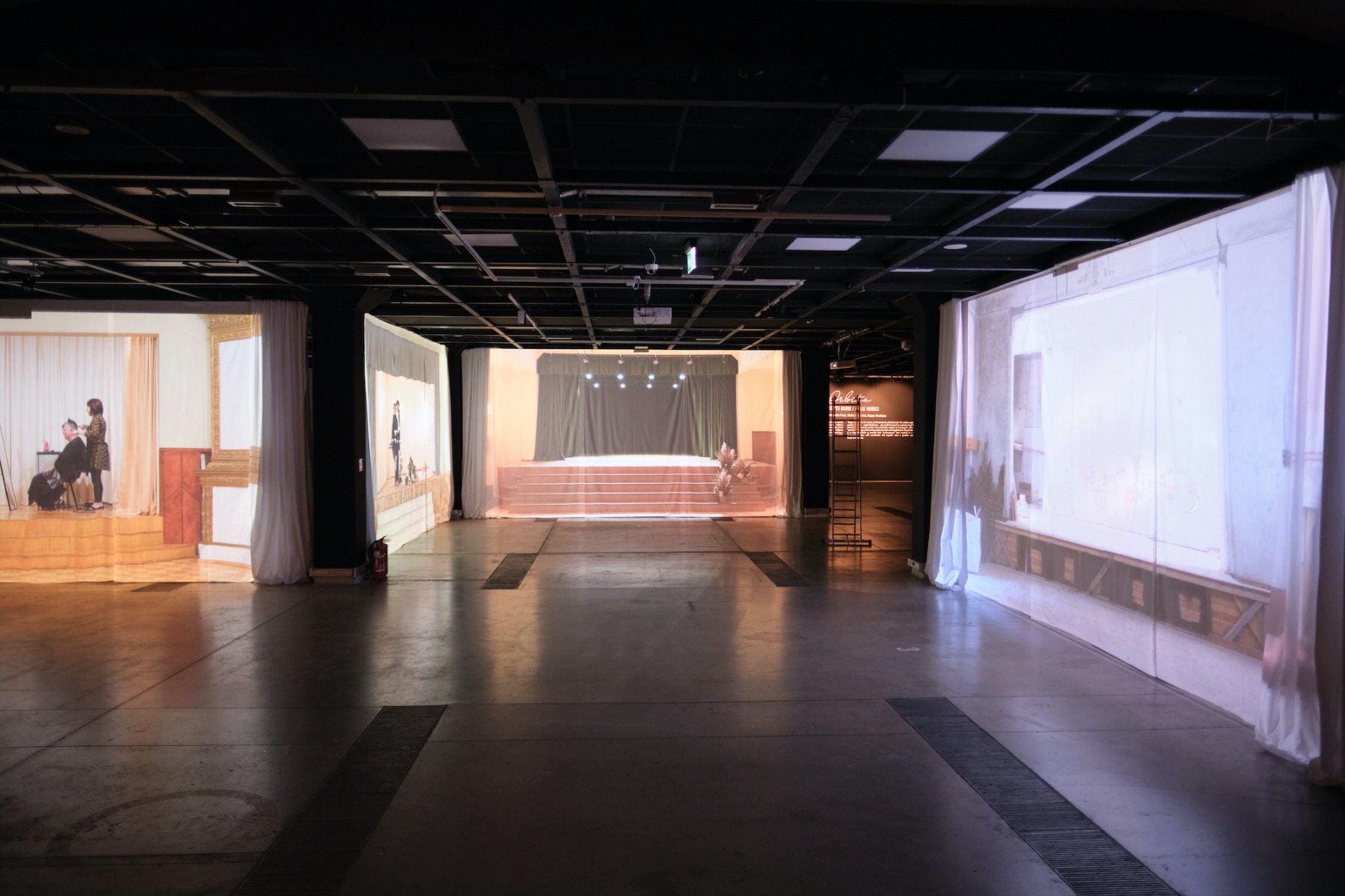
Orbita. Stage Works
Until 29 December
On the stages of cultural centers of small towns and villages near the city of Valmiera a firewood is split, branches are chopped, dogs are trained, hair is cut – completely mundane practical activities that usually do not happen on stage are captured on video, resulting in a multichannel video installation, where overlapping video and sound projections create delightfully unexpected space-sound continuum.
The project "Stage Works" brings provincial stages to one of the largest contemporary art institutions in Latvia, addressing a range of themes and questions without trying to give clear-cut answers. Among them is a question of the survival of cultural and community centers in less populated areas, which is often approached from a purely economic point of view. Ironically, Orbita seems to manifest this approach by bringing to the stage entirely practical activities-services. Besides raising the question of boundaries between art and "life", these staged mini-plays "memorialize" common in demand professions of our time.
Kim? Contemporary Art Centre

Eike Eplik, Kristi Kongi, Anna Mari Liivrand. White Dwarfs and All Those Beautiful Nebulas
28 November – 26 January
The practices of Eike Eplik, Kristi Kongi and Anna Mari Liivrand do not focus on studies of cosmology, yet their observations of the world and contemplations about it mirror the processes taking place in the universe. They study and question the world they inhabit – whether that’s the natural world, culture, emotions, dreams or memories. The worlds they create constantly expand and transform, not letting themselves be identified as a single form or message. Each using their own set of skills, media and forms of artistic expression, they present visions of the world as a liquid entity in constant metamorphosis. In the exhibition, they take up a certain role play by mimicking the processes happening with white dwarfs, and by closely collaborating, they build narratives that echo each other.
In this imaginary cosmic time-space, Anna Mari Liivrand takes on the symbolic role of the white dwarf. Trained as a sculptor, she works in a wide spectrum of media, exploring fragility, evanescence and melancholy in today’s society. Many of her sculptures take inspiration from sacral architecture, including graveyard fences and reliquaries, which are recurring motifs in her works, together with ornaments, decorations and readymades that she uses as anchor points in an ever-changing world. This surreal frozen landscape evaporates in the colourful shadow worlds created by painter Kristi Kongi, who is the nebula in this metaphor. Kongi’s artistic approach can be described as fluid and in constant motion. The motifs and compositions float and develop instead of rapidly changing. Her sight is fixed on certain horizons, which she studies with the help of light, colour and shadow-like forms. Eike Eplik is deeply fascinated by biodiversity and its complicated relationship with humankind. She creates sensitive and imaginative works full of personal mythology, using different visual expressions and materials such as clay and metal. Similar to the ideas of philosopher Astrida Neimanis about water-connected worlds, the artist takes a humble approach to all living things; in her art, strictly defined categories, hierarchies, genders and bodies do not exist. Her work can be described as micro-worlds, like bestiaries, inhabited by fantastic creatures in combination with plant forms including fungi, roots, and cones.
Zuzeum Art Centre
UTOPIC CELLS. 2024. Photo: Ansis Starks
Donna Huanca. Utopic Cells
Until 24 November
UTOPIC CELLS is a solo exhibition by American artist Donna Huanca. This multi-sensory project incorporates painting, sculpture, video, sound, and scents. UTOPIC CELLS marks the artist’s most comprehensive, large-scale, solo institutional exhibition in the Baltics. The exhibition presents a multi-dimensional landscape guiding the viewer through a translucent, biodegradable membrane that creates a new architecture within the open plan of Zuzeum. These translucent “cells” sculpt and shape the space, dividing them into a multitude of intimate enclosures while gradually expanding and contracting as we progress through the exhibition.
Donna Huanca builds a new and experimental scenery with each of her installations, always hinting at previous bodies of work and still, crafted with attention for its singular context and architecture. She uses materials intimately connected to the natural world, such as oils, sand, and clay. Huanca’s paintings exist as microcosms of her performances, which involve painted bodies adorned with clay, textile, or pigments. Canvases are enlivened by fragments of paint, latex, and other artificial yet skin-like materials, entering in an intimate dialogue with the surrounding organic components, overlaid with a dense, gestural layering of paint reminiscent of ritual and ceremonial practices. Donna Huanca’s totemic sculptures merge clothing, natural fibers, synthetic hair and other cultural artifacts, which are then taken apart and reassembled to build intricate and abstract three-dimensional entities. Coated in textured paint mixed with sand, these shapes shelter and display parts of the exhibition space, drawing on natural mineral patterns and rock formations, recalling the pigments used in her paintings. Embedded in the installation are sound and scent works that further immerse the viewer in this multi sensory universe.
ISSP gallery
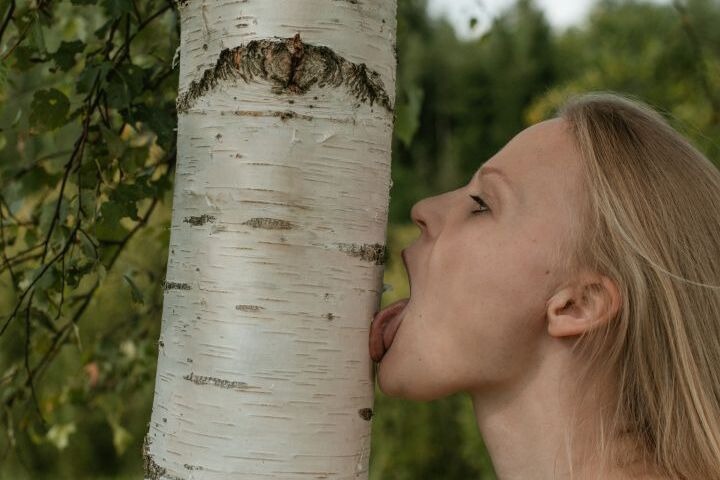
Anna Maskava: Ancestral Body
Until 31 January
The hybrid, synthesized, and transdisciplinary art forms created by Anna Maskava blur the boundaries between nature and technology, two-dimensional images and processes, as well as the human and the non-human world. The artist plays and performatively intervenes in both nature and the material world, as well as in various media and technologies, revealing a multiplicity of nonlinear, interconnected narratives.
Anna Maskava (1990) is a transdisciplinary artist working in the field of visual arts, primarily focusing on the means of expression in photography and performance art, especially their synthesis. In photography, Anna works within the self-portrait genre and purposefully creates her own system of imagery and visual codes that allow her to transpose individual experiences into symbols, allegories, and metaphors.
LOOK! Gallery
Estonian artist Laura Põld with her new works. Photo: Albert Kerstna
Laura Põld. She Is Thinking About the Flammable Nature of Things
Until 30 November
She is Thinking About the Flammable Nature of Things is Laura Põld’s first solo show in Latvia, hosted by LOOK! Gallery. The exhibition features new installations and objects that Põld has constructed by mixing such materials as ceramics, steel, and textiles to investigate the nuanced layers of corporeality and vulnerability.
For many years, Laura Põld has been interested in the agency and expressiveness of materials and media. Her works intertwine organic and artificial materials, referencing the fragility of matter and drawing attention to different layers of temporality. Alongside materiality and craftsmanship, her approach embraces technical failures, welcoming the unpredictability of life with an ironic and contemplative commentary on the challenges of navigating existence. Laura Põld’s artworks present layers of material referencing places and contexts that have shaped her practice. In the new exhibition, viewers can encounter sculptural and craft-based forms and motifs, where one can sense the natural coexistence of absurdity and joy for experimentation. Communicated through eclectic techniques and the bold self-awareness of the forms, these immersive works become the thresholds for an artist entering a new decade.
Galerija ASNI
Angela Maasalu. Crocodile. 2023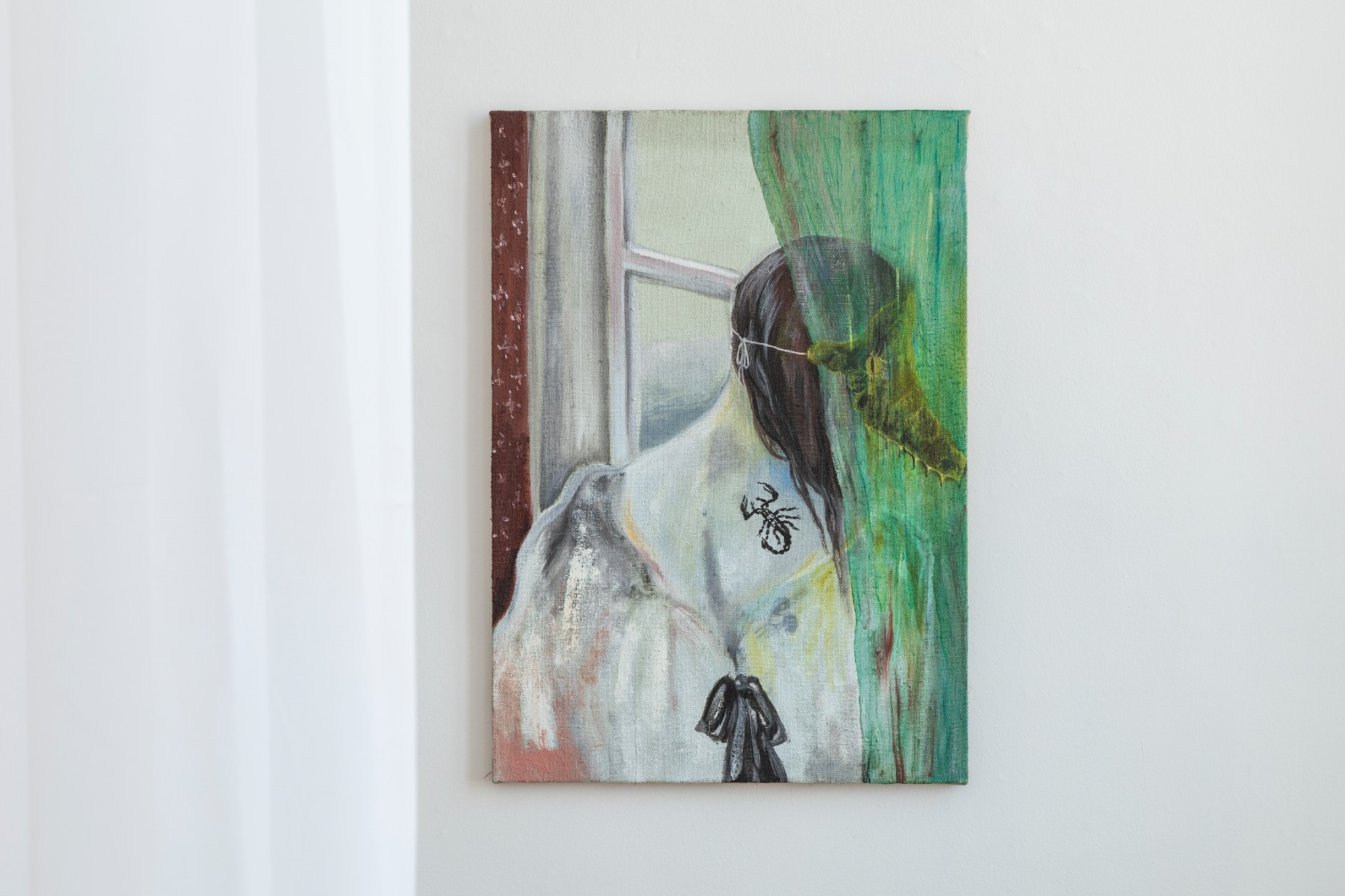
Ingmar Järve, Mariann Metsis, Kati Saarits, Angela Maasalu. Shifting Sands
Until 7 December
Shifting Sands brings together Estonian artists Ingmar Järve, Mariann Metsis, Kati Saarits, and Angela Maasalu in an exploration of memory’s mutable nature, drawing on Svetlana Boym’s concept of reflective nostalgia. Through their distinct practices, the artists engage with historical narratives, personal loss and domestic rituals, allowing fragmented elements to surface and shift. The works in this exhibition suggest that memory is fluid, continually reframing our relationship to the past and its impact on the present. The exhibition was curated by Lilian Hiob-Küttis
TUR_telpa
Photo: noizebro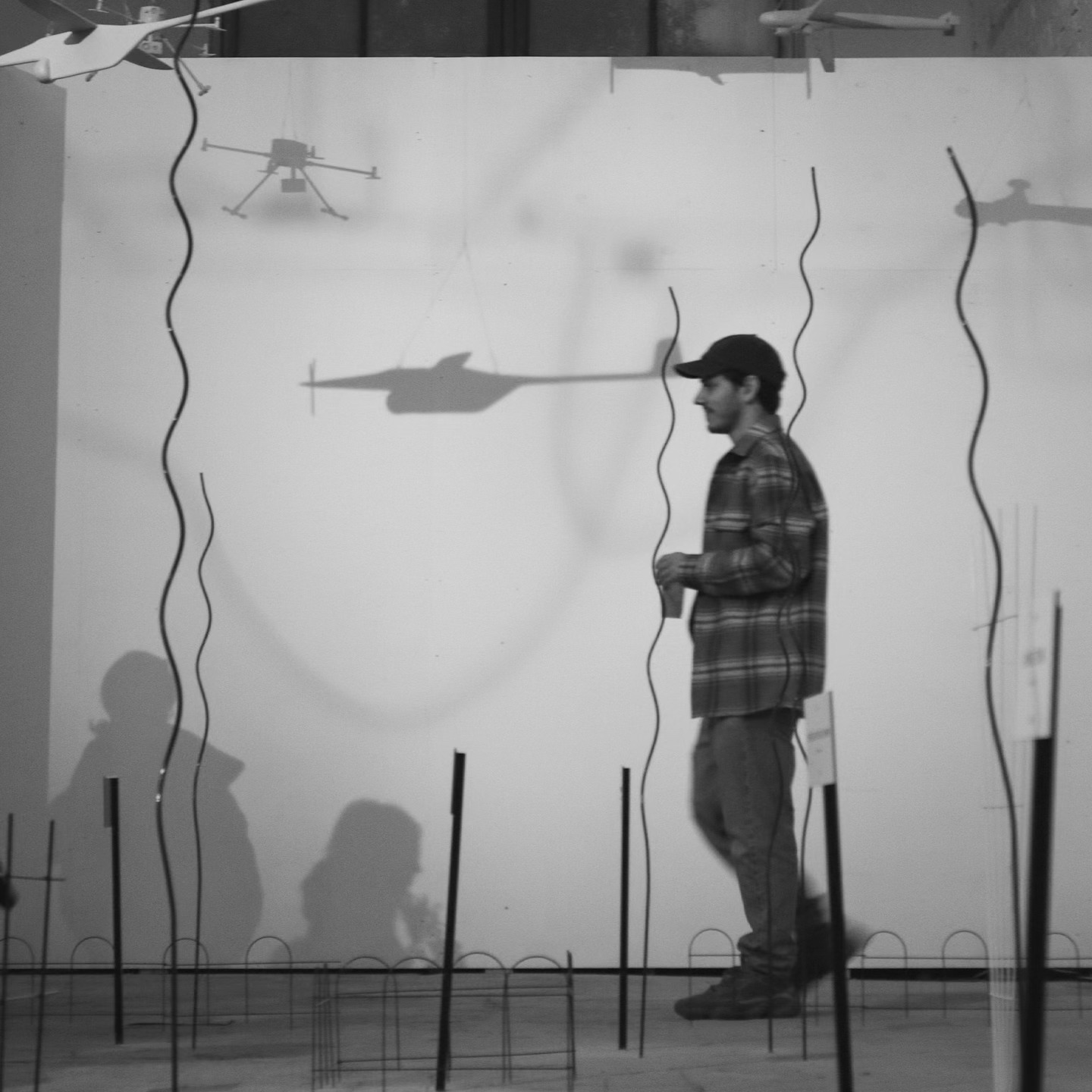
Katrina EW, Oto Holgers Ozoliņš, Kristina Rezviha, Patrīcija Māra Vilsone. Liminal Limbo
Until 30 November
Liminal Limbo brings together new work from four artists – Katrina EW, Oto Holgers Ozoliņš, Kristina Rezviha, and Patrīcija Māra Vilsone – who are on the cusp of Generation Z and Millennials. The premise of the exhibition is for these artists to create personal reflections on the times we live in, specifically from the perspective of a generation that has just begun to arrive on the scene and participate in cultural conversations with voices that carry significant and insightful reflections on humanity and the future course of history. As with every generation, Gen Z is shaped by the events and technological shifts that have occurred during their formative years. Gen Z is often characterized by their adaptability, social consciousness, and digital fluency, though they also face challenges such as heightened anxiety and a tendency towards instant gratification. This characterization reflects not only the influence of previous generations but might also offer a fresh point of view.
A vital fifth contribution to Liminal Limbo, complementing the work of the artists, comes from three architecture and design students from RISEBA – Reinijs Acht, Nikita Merkushin, and Kate Onckule – who, like the artists, navigate the liminal space between Gen Z and Millennials. Tasked with creating a liveable environment within TUR’s expansive space, their project mirrors the broader challenges faced by Gen Z. As they designed and built their structure alongside the exhibition, it became a reflection of the precarious future their generation inherits, where resources grow scarce and funding for creative ventures continues to dwindle. By repurposing materials from TUR’s previously dismantled cube, the students' design not only transforms the space physically but also serves as a metaphor for the adaptive resilience required of their generation – crafting something meaningful out of the remnants of what came before, even in uncertain times.
LITHUANIA, Vilnius
Contemporary Art Centre (CAC)
Death, circa 1970s, silver gelatin print attributed to Elia Lekodimitri under the pseudonym Emerson. Photograph courtesy of The George Tourkovasilis Estate
15th Baltic Triennial: Same Day
Until 12 January
The Baltic Triennial was first held in Vilnius in 1979 as an exhibition showcasing young Baltic artists working in a non-conformist spirit. Since then it has grown into a major international exhibition in Northern Europe. The upcoming edition is the first international exhibition to be held at the Contemporary Art Centre (CAC) since its reopening after 3 years of renovation. According to Kęstutis Kuizinas, Director of the CAC Vilnius, ‘The curatorial vision for the 15th Baltic Triennial invites us to imagine a ray of light refracting through a prism and transforming into a multitude of narratives that complement, extend and challenge each other. The curators’ multidimensional gaze is directed towards an intuitive perception of the world, based on poetic principles and mechanisms, and through them, seeks engagement with the complex reality and awareness of the ever-changing (geopolitical) reality. I believe that it is this sensitively balanced curatorial approach that will meaningfully continue the history of the Baltic Triennial.”
Same Day includes contributions by Rey Akdogan, Nick Bastis, Kazimierz Bendkowski, Geta Brătescu, Matt Browning, Tom Burr, Elene Chantladze, Josef Dabernig, Aria Dean & Laszlo Horvath, Gintaras Didžiapetris, Jason Dodge, Kevin Jerome Everson, Simone Forti, Michèle Graf & Selina Grüter, Villu Jõgeva, Tarik Kiswanson, Michael Kleine, Běla Kolářová, Jiří Kovanda, Kitty Kraus, Bradley Kronz, Kaarel Kurismaa, Simon Lässig, Ian Law, Klara Lidén, Jolanta Marcolla, Ugnė Nakaitė with Urtė Jarmuškaitė & Pranas Gustainis, Elena Narbutaitė, Ewa Partum, Matthew Langan-Peck, Julie Peeters & BILL, Cameron Rowland, Margaret Salmon, Stephen Sutcliffe, Tanya Syed, Jean-Marie Straub & Danièle Huillet, Raša Todosijević, Thanasis Totsikas, Maria Toumazou, Rosemarie Trockel, Christos Tzivelos, Mare Vint, Tanja Widmann, Marina Xenofontos, and Eiko Yamazawa. The exhibition is curated by Tom Engels and Maya Tounta.
MO Museum

From Within
Until 31 August
An attentive and purposeful encounter with art has a positive effect on health. Works of art are multifaceted and integrate various aspects within them – which is why interacting with them has a healing power. Art speaks to us and helps develop resilience, the ability to cope with arising difficulties and act consciously. When we stand still and exist within our internal reaction to a work of art, we allow ourselves to open up to different interpretations and understand our experience in a new way, through different eyes. From Within is the first exhibition in Lithuania to combine art history and psychology on such a scale. By relying on these two disciplines, we encourage reflection on the multifaceted impact of art. The tools of art history help us understand visual language, while psychology guides us toward self-analysis. The questions that accompany this exhibition connect these two fields – like Ariadne’s thread, they help maintain a direction of looking and thinking, compelling us to open up and experience the therapeutic effect of art.
National Gallery of Art
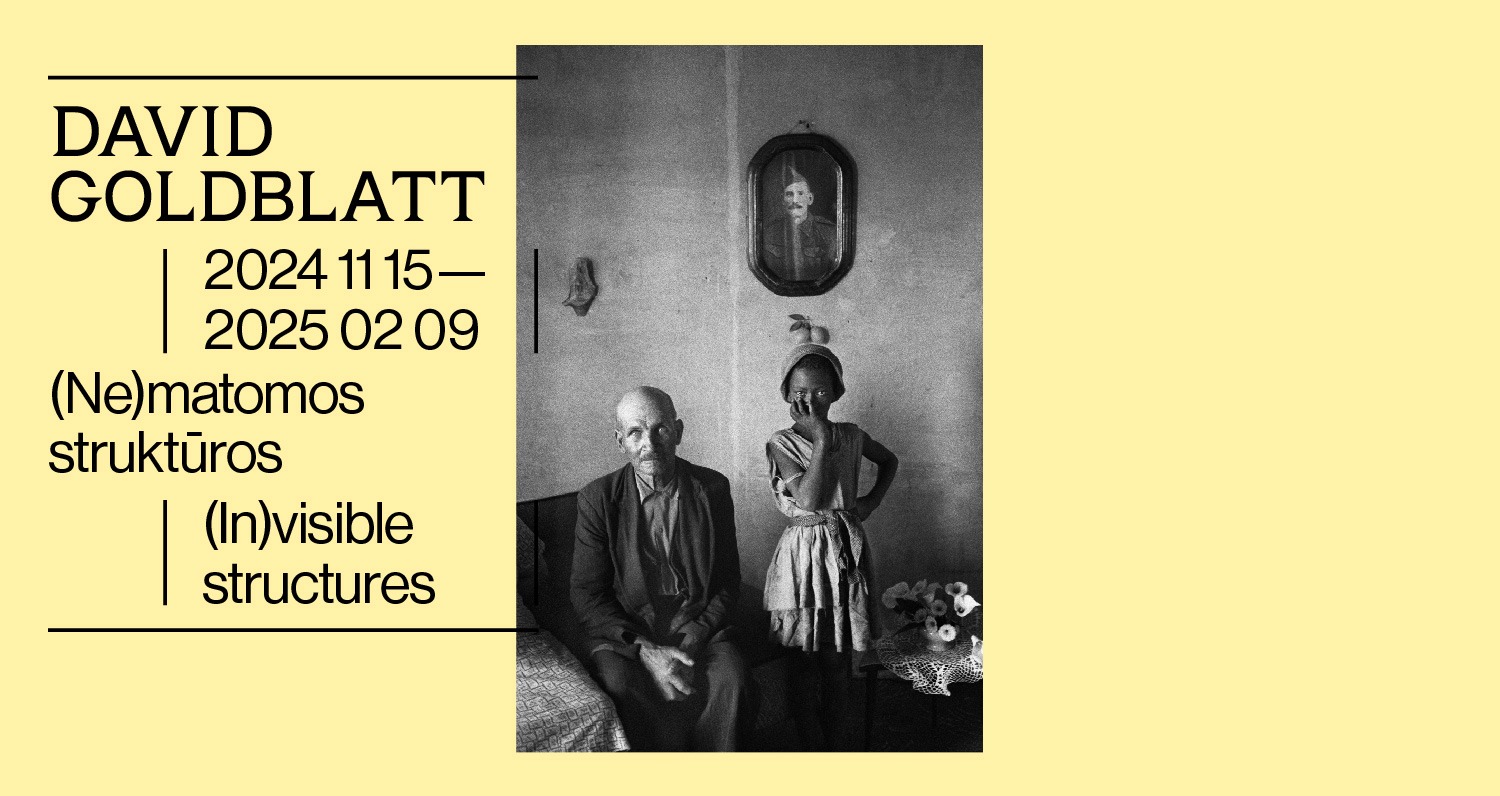
David Goldblatt: (In)Visible Structures
15 November – 9 February
A major exhibition of David Goldblatt (1930–2018), one of South Africa’s most important documentary photographers, will be on view at the Lithuanian National Museum of Art (LNMA) from 16 November 2024 to 9 February 2025. As an engaged and perceptive observer of complex social issues under apartheid and after its collapse, Goldblatt embodied a critical view of reality in his work. The exhibition presents over one hundred black-and-white and colour photographs, offering a comprehensive look at Goldblatt’s oeuvre, including iconic images from his most significant series, such as On the Mines, Some Afrikaners Photographed, and Structures.
Goldblatt’s Structures, initiated in 1983 and continued for over thirty years, offers a visual history of public spaces and landscapes shaped in South Africa from the colonial era onwards. Through a series of images depicting churches, monuments, public buildings, and urban and agricultural landscapes, the photographer reveals how all constructions reflect the beliefs and ideologies of those who design and use them. As the author himself says, the way we shape landscapes, particularly through architecture and other forms, is ‘eloquent of the needs, preferences, imperatives, and values of those who made and use them.’ The exhibition section First Series presents photographs that brought Goldblatt early recognition. Although he began taking photographs as a teenager, he only devoted himself to photography professionally at the age of 33. At that point, he started working for corporations and magazines while also pursuing his own projects. On The Mines is the earliest of his mature series, focusing on the reality of the gold mines that formed the backbone of South Africa’s economy for most of the 20th century. Some Afrikaners Photographed reveals the everyday life of South Africa’s white, mostly rural, and often poor population.
Jonas Mekas Visual Art Center
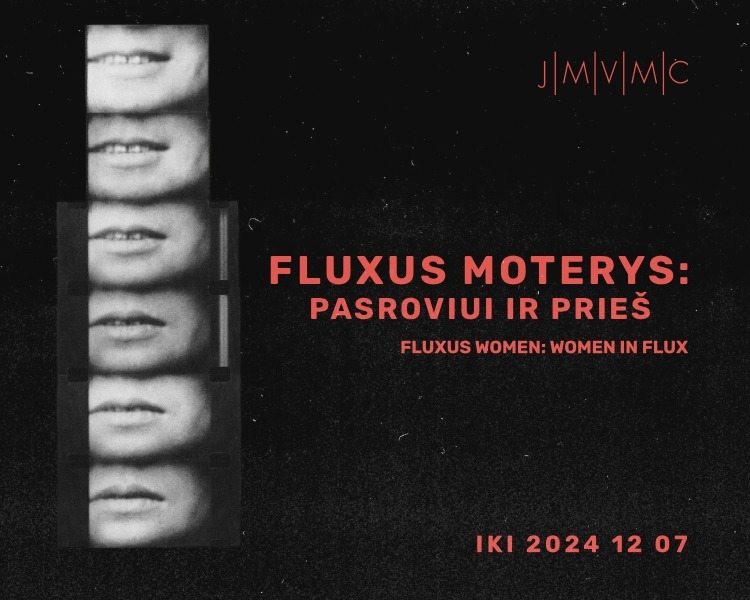
Fluxus women: women in flux
Until 7 December
Fluxus was known as one of the most democratic art movements, involving creators of diverse races, nationalities, and genders. However, in 20th-century art history, we mostly find the names of male artists. Yet, from the very beginning, women artists actively engaged in the community of artistic rebels organized by George Maciunas—independently and collectively, alone and with partners.
This exhibition showcases objects, photographs, performance documentation, exhibition invitations, books, and films by Yoko Ono, Alison Knowles, Shigeko Kubota, Alice Hutchins, Carla Liss, Kate Millett, Charlotte Moorman, Nye Ffarrabas (formerly Bici Forbes Hendricks), Simone Forti, Billie Hutching (Maciunas), and others. Fluxus was famous for its democratic approach to art, which was meant to be “accessible to everyone”—thus often inexpensive, easily reproducible, small in scale, and fitting into the Fluxus boxes and drawers designed by George Maciunas. This exhibition is drawn from Jonas Mekas’s Fluxus collection, highlighting the bold experiments by women artists with their bodies, language, space, and music. Some artists, like Mieko Shiomi, gathered other creators, involving Vytautas Landsbergis in the global “Spatial Poems” performance project, while others went against the flow—like Kate Millett, a second-wave feminist pioneer known for her book Sexual Politics, or Charlotte Moorman, whose independent art practice even angered the Fluxus “pope” George Maciunas, leading to her being “expelled” from the movement. Yet, most importantly, these artists themselves created new forms of art and communication, critically reflecting on the status of women in society at the time.
Vilnius Picture Gallery
The Young Painter's Prize
12 November – 25 January
The Young Painter’s Prize (YPP) is one of the most significant art events in the Baltic States, which has been held since 2009. This project unites the young painters of Lithuania, Latvia and Estonia for a common goal – to present the identity of the Baltic States through personal creative potential. The main goal of the project is to present the most promising and brightest painters of the young generation, to provide an opportunity for the public to get acquainted with the work of young artists, and for the targeted audience in Lithuania and abroad – art collectors, art managers and curators – to discover new talents in the Baltic countries. YPP aims to present artists working with traditional painting media under the age of 33.
The exhibition of the 33 finalists of the competition is held in the Lithuanian National Art Museum, Picture Gallery of Vilnius
The Radvila Palace Museum of Art
NSRD: Information About a Transformed Situation
22 November –25 February
The Latvian Centre for Contemporary Art (LCCA), in partnership with the Lithuanian National Museum of Art (LNMA), opens NSRD: Information About a Transformed Situation – an exhibition dedicated to the legendary Latvian avant-garde music and art group Workshop for the Restoration of Unfelt Feelings (NSRD) and their associates. This exhibition, on view at the Radvila Palace Museum of Art of the LNMA until February 23, 2025, is the broadest display of NSRD's work to be organized outside of Latvia in 35 years and provides an opportunity for international audiences to be introduced to the recent history of Latvian underground art and its continued influence today. The exhibition has been curated by Māra Traumane (Art Academy of Latvia) and Māra Žeikare (Latvian Centre for Contemporary Art).
NSRD, as an interdisciplinary group, was active in the fields of music, literature, performance and video art. The group was founded in 1982 by Juris Boiko and Hardijs Lediņš, who were joined by their long-term associates Inguna Rubene (Černova) and Imants Žodžiks. However, their projects often involved a much wider circle of participants, and not all of the projects developed by the members of this wider group – which included actions, design, architecture proposals and discotheques – can be linked to NSRD directly. The exhibition NSRD: Information About a Transformed Situation is focused on the various models of creative collaboration seen in the work of the group from the late 1970s till 1989. Despite the restrictions of the Soviet time, these activities allowed the introduction of cutting-edge avant-garde, new wave and postmodern aesthetics into the Latvian cultural scene. In the exhibition, the continuity of the legacy of NSRD is reflected in the works of the artists Maija Kurševa, Evita Vasiļjeva, Kaspars Groševs, the text group Orbīta (Semjons Haņins, Artūrs Punte, Vladimirs Svetlovs, Sergejs Timofejevs) and the band Alejas (Kirils Ēcis, Spāre Vītola, Reinis Žodžiks).
Galerija Vartai
Neringa Vasiliauskaitė. Pea blossom. Detail
Neringa Vasiliauskaitė. Repetitions & Rituals
Until 27 Novemeber
The exhibition will showcase the artist’s latest series of works, created for the Kunstraum München exhibition, curated by Lena von Geyso and Patricia Drück. Neringa Vasiliauskaitė‘s cycle of new site-specific works ties in with moments of memory from her childhood. The multilayered and ambiguous works, installed both on the wall and in the room, function as metaphors for repetitive everyday rituals and prompt viewers to examine the transformation of different aggregate states, strands of time, and the emotions and meanings associated with these.
Her large - and small-format objects made of printed textiles on padded backgrounds and covered with epoxy resin and incorporated wooden elements, blur the boundaries between inside and outside and open a dialogue between material (transfer) and repetition, imitation and contradiction. Shiny surfaces are reminiscent of leather upholstery or human skin, like an artificially created body; seemingly solid surfaces become fluid, soft ones cure and harden or reproduce themselves in form and texture. Neringa Vasiliauskaitė’s artistic practice is influenced by Xenofeminism and the theories of psychoanalyst Didier Anzieu, among others. The artist is interested in how an object takes in its environment and then reflects it back through its surface, its skin, as if it were carrying information from different cultural layers and generations.
Editorial Project Space
Daria Melnikova. Treausure Hunt. 2024. 
Daria Melnikova. Treasure Hunt
Until 30 November
Conceived specially for the Editorial Space, Treasure Hunt is created as the artist’s personal ‘museum of life,’ presenting her key exhibits: inspirations, experiences, memories, joys, and sorrows. Through associative forms and imagery, these elements weave a metaphorical and ironic narrative that unfolds over a decade of artistic practice. The piece tells of a continuous quest for balance in the labyrinth of everyday hopes, where the ‘treasure’ is that elusive moment of peace amid routine, stress, and pressure. Each daily task becomes part of a broader journey in search of small yet meaningful ‘treasures’ – moments of joy that can appear as a spark of inspiration during a walk or a guilt-free bag of potato chips devoured in delight.
The two-sided structure draws inspiration from Melnikova’s earlier works and mimics a treasure map, an eclectic collage of details unified by shades of white that form a subtle background. This serves as a blank canvas for her latest works – A Woman in Agrodolce and Apericena Dorata – which mix traditional and modern techniques with clear references to Renaissance art, celebrating the beauty found in everyday experiences. Treasure Hunt invites us to appreciate daily existence, highlighting moments that might otherwise go unnoticed. It encourages us to seek beauty in our surroundings and fosters a deeper connection to the ordinary aspects of life.
Lithuanian Art Centre TARTLE

Solely Saints
Until 1 May
The exhibition Solely Saints welcomes you to explore depictions of saints spanning from the 16th century to contemporary times. Among them, you’ll encounter creations by artists who refined their craft over many years of practice, alongside works crafted by self-taught village god-makers who fashioned these figures in accordance with their faith and individual methods and means. Within the exhibition, folk art and professional works converge around thematic elements, offering a unique juxtaposition that illustrates how self-taught folk artists and trained professionals alike interpret the same Christian iconographic themes.
Comprising over 150 pieces, the exhibition draws from the extensive TARTLE collection as well as contributions from other private collections. The exhibition aims not only to unveil these treasures from private collections but also to underscore the enduring affinity of artists for Christian imagery and the collectors’ inclination to cherish them as objects of devotion.
Title image: Gunārs Binde. Flight. 1992

